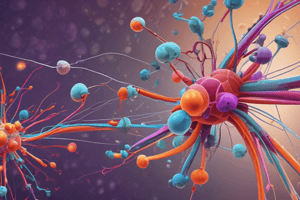Podcast
Questions and Answers
What is a primary role of activation-transfer coenzymes?
What is a primary role of activation-transfer coenzymes?
- Act solely as electron carriers without bonding
- Participate directly in catalysis by forming a covalent bond with substrates (correct)
- Form covalent bonds with genes
- Facilitate hydrogen ion exchange only
Which vitamin is a precursor to thiamine pyrophosphate (TPP)?
Which vitamin is a precursor to thiamine pyrophosphate (TPP)?
- Vitamin B6
- Vitamin B2
- Vitamin C
- Vitamin B1 (correct)
How does alcohol affect the absorption of vitamin B1?
How does alcohol affect the absorption of vitamin B1?
- Inhibits its absorption by damaging intestinal lining (correct)
- Has no effect on vitamin B1 absorption
- Increases its absorption in the intestine
- Enhances the metabolic activity of B1 in the liver
What type of coenzyme is NAD+ and what vitamin is it derived from?
What type of coenzyme is NAD+ and what vitamin is it derived from?
Which coenzyme is synthesized from pantothenate (B5)?
Which coenzyme is synthesized from pantothenate (B5)?
Which coenzyme specifically participates in carboxylation reactions?
Which coenzyme specifically participates in carboxylation reactions?
Which of the following statements is true regarding redox coenzymes?
Which of the following statements is true regarding redox coenzymes?
What common feature do oxidation-reduction coenzymes share?
What common feature do oxidation-reduction coenzymes share?
Which of the following is classified as a conditionally essential amino acid during periods of rapid growth?
Which of the following is classified as a conditionally essential amino acid during periods of rapid growth?
What defines a cofactor in relation to enzymatic reactions?
What defines a cofactor in relation to enzymatic reactions?
Which vitamin is known to primarily serve as an antioxidant?
Which vitamin is known to primarily serve as an antioxidant?
What is a characteristic feature of water-soluble vitamins concerning toxicity?
What is a characteristic feature of water-soluble vitamins concerning toxicity?
Which nutrient is considered a trace mineral essential for cellular homeostasis?
Which nutrient is considered a trace mineral essential for cellular homeostasis?
What is the main role of vitamins in relation to enzymes?
What is the main role of vitamins in relation to enzymes?
Which of the following vitamins is classified as fat-soluble?
Which of the following vitamins is classified as fat-soluble?
Which factor would make an amino acid conditionally essential?
Which factor would make an amino acid conditionally essential?
What occurs as a consequence of enzyme deficiencies in trace metal homeostasis?
What occurs as a consequence of enzyme deficiencies in trace metal homeostasis?
Which of the following best describes prosthetic groups?
Which of the following best describes prosthetic groups?
What distinguishes essential nutrients from nonessential nutrients?
What distinguishes essential nutrients from nonessential nutrients?
Which of the following statements is true about fat-soluble vitamins?
Which of the following statements is true about fat-soluble vitamins?
Which micronutrient category does copper belong to?
Which micronutrient category does copper belong to?
What role do coenzymes play in enzymatic reactions?
What role do coenzymes play in enzymatic reactions?
Which of the following vitamins is classified as water-soluble?
Which of the following vitamins is classified as water-soluble?
What characterizes conditionally essential amino acids?
What characterizes conditionally essential amino acids?
What can result from deficiencies in trace metal homeostasis?
What can result from deficiencies in trace metal homeostasis?
What is a primary role of thiamine pyrophosphate (TPP) as an activation-transfer coenzyme?
What is a primary role of thiamine pyrophosphate (TPP) as an activation-transfer coenzyme?
Which statement correctly describes oxidation-reduction coenzymes?
Which statement correctly describes oxidation-reduction coenzymes?
How does the body handle micronutrients in terms of storage?
How does the body handle micronutrients in terms of storage?
What defines a prosthetic group in relation to coenzymes?
What defines a prosthetic group in relation to coenzymes?
What condition can result from alcohol consumption regarding vitamin B1?
What condition can result from alcohol consumption regarding vitamin B1?
Which of the following coenzymes is involved in carboxylation reactions?
Which of the following coenzymes is involved in carboxylation reactions?
Which group of vitamins primarily serve as coenzymes for energy metabolism?
Which group of vitamins primarily serve as coenzymes for energy metabolism?
Which function distinguishes NAD+ among the oxidation-reduction coenzymes?
Which function distinguishes NAD+ among the oxidation-reduction coenzymes?
Which of the following vitamins is not derived from the corresponding coenzyme?
Which of the following vitamins is not derived from the corresponding coenzyme?
What impact do vitamin deficiencies have on enzymatic activity?
What impact do vitamin deficiencies have on enzymatic activity?
Which coenzyme is synthesized from biotin?
Which coenzyme is synthesized from biotin?
Flashcards are hidden until you start studying
Study Notes
Coenzymes and Prosthetic Groups
- Prosthetic groups remain attached to proteins until degradation occurs.
- Coenzymes are divided into two general classes:
- Activation-transfer coenzymes: Involved in direct catalysis through covalent bond formation.
- Oxidation-reduction coenzymes: Facilitate electron transfer with specific functional groups.
Activation-Transfer Coenzymes
-
Thiamine pyrophosphate (TPP):
- Derived from vitamin B1 (thiamin).
- Involved in the oxidation of α-keto acids and decarboxylation reactions.
- Forms a covalent bond with substrates, enhancing nucleophilicity.
- Alcohol can inhibit B1 absorption by damaging intestinal lining.
-
Other activation-transfer coenzymes include:
- Coenzyme A (CoA): Synthesized from pantothenic acid (B5).
- Biotin: Originates from biotin (B7).
- Pyridoxal phosphate (PLP): Derived from pyridoxine (B6), essential for carboxylation reactions.
Oxidation-Reduction Coenzymes
- NAD+: Derived from niacin (B3).
- FAD: Derived from riboflavin (B2).
- These coenzymes do not form covalent bonds with substrates.
- They have unique functional groups for accepting and donating electrons.
- Other notable redox coenzymes: Vitamin C and E, which work with metals for single-electron transfer to oxygen.
Vitamins and Enzyme Function
- Vitamins function as essential organic substances that do not provide energy but assist in tissue maintenance and growth.
- Water-soluble vitamins serve as coenzymes for many energy metabolism enzymes and act as antioxidants.
- Fat-soluble vitamins include A, D, E, and K.
Nutrient Classifications
- Macronutrients: Carbohydrates, fats, and proteins.
- Micronutrients: Vitamins and minerals that are crucial for cellular homeostasis.
- Essential nutrients cannot be synthesized by the body and must be obtained from food.
- Nonessential nutrients can be synthesized, though not always in sufficient quantities.
- Conditionally essential nutrients are crucial during periods of stress or development.
Amino Acids
- Classified as essential or nonessential:
- Essential amino acids must be acquired from the diet.
- Conditionally essential amino acids include arginine and histidine, especially vital during pregnancy and periods of rapid growth.
Deficiency and Toxicity
- Micronutrient deficiencies can severely impact enzyme function and overall metabolism.
- Excessive levels of micronutrients can lead to toxicity, so their intake must be carefully regulated.
Cofactors
- Cofactors are essential for enzyme function, forming either intermolecular or covalent bonds during reactions.
- Common cofactors include metal ions (Zn, Fe, Mg, Ca) and organic molecules.
- Coenzyme-dependent enzymes start as apoenzymes that require cofactors for catalysis.
- Prosthetic groups are tightly associated cofactors crucial for certain enzymes.
Coenzymes and Cofactors Overview
- Coenzyme: Organic molecules participating in enzymatic reactions as non-protein components.
- Cofactor: Inorganic or organic substances required for enzyme activity, forming bonds during reactions.
- Prosthetic Group: Tightly bound cofactors, typically not dissociating until protein degradation occurs.
- Apoenzyme: Inactive form of an enzyme without its cofactor.
- Holoenzyme: Active enzyme formed when an apoenzyme is combined with its cofactor.
Role of Vitamins
- Vitamins function as essential organic compounds necessary for growth and tissue maintenance.
- Water-soluble vitamins serve as coenzymes, assisting in energy metabolism and functioning as antioxidants.
- Lipid-soluble vitamins support various biochemical processes but are less likely to cause toxicity as they do not accumulate in the body (except B2).
Essential Nutrients
- Essential nutrients cannot be synthesized by mammals; must be obtained from food.
- Nonessential nutrients can be synthesized but may not be produced in sufficient amounts for optimal health.
- Conditionally essential nutrients may become critical during illness, stress, or developmental phases.
Micronutrient Homeostasis
- Micronutrients (vitamins and minerals) are vital for cellular functions and must be strictly regulated.
- Deficiencies can disrupt homeostasis, leading to various health issues.
- Toxicity can occur due to excessive intake of certain micronutrients.
Classification of Dietary Nutrients
- Macronutrients: Carbohydrates, fats, proteins, essential fatty acids, and amino acids.
- Micronutrients: Vitamins (water and lipid-soluble), minerals (electrolytes and trace minerals).
- Key water-soluble vitamins: Vitamin C, B complex.
- Important lipid-soluble vitamins: Vitamins A, D, E, and K.
Cofactors and Enzyme Activation
- Cofactors enhance enzyme action, often metal ions like Zn, Fe, Mg, and Ca.
- Many coenzymes are derived from vitamins, essential for catalysis.
- Vitamin-derived coenzymes include TPP (B1), CoA (B5), biocytin (B7), and pyridoxal phosphate (B6).
Types of Coenzymes
- Activation-transfer coenzymes: Participate directly in catalytic processes, forming covalent bonds with substrates, increasing enzyme specificity and catalytic power.
- Redox coenzymes: Involved in oxidation-reduction reactions, accepting and donating electrons without forming covalent bonds.
Key Activation-Transfer Coenzymes
- Thiamine pyrophosphate (TPP): Aids in oxidation of α-keto acids and decarboxylation reactions. Alcohol consumption may inhibit thiamine absorption in the intestines.
- Coenzyme A (CoA): Derives from pantothenic acid, integral in various metabolic pathways.
- Biotin: Synthesized from biotin (B7), plays a role in carboxylation reactions.
- Pyridoxal phosphate (PLP): Derived from pyridoxine (B6), essential for carboxylating reactions in various enzymes.
Redox Coenzymes
- NAD+: Derived from niacin (B3), significant in energy metabolism.
- FAD: Derived from riboflavin (B2), participates in redox reactions.
- Specific for their electron transfer forms; work alongside compounds like vitamins C and E to facilitate electron transfer.
Impact of Vitamin Deficiencies
- Vitamin deficiencies critically affect enzyme function, disrupting metabolic pathways and leading to various health issues.
Studying That Suits You
Use AI to generate personalized quizzes and flashcards to suit your learning preferences.



